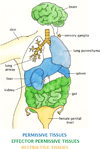Tissue-resident memory T cells - PubMed (original) (raw)
Review
Tissue-resident memory T cells
Haina Shin et al. Immunol Rev. 2013 Sep.
Abstract
Tissues such as the genital tract, skin, and lung act as barriers against invading pathogens. To protect the host, incoming microbes must be quickly and efficiently controlled by the immune system at the portal of entry. Memory is a hallmark of the adaptive immune system, which confers long-term protection and is the basis for efficacious vaccines. While the majority of existing vaccines rely on circulating antibody for protection, struggles to develop antibody-based vaccines against infections such as herpes simplex virus (HSV) and human immunodeficiency virus (HIV) have underscored the need to generate memory T cells for robust antiviral control. The circulating memory T-cell population is generally divided into two subsets: effector memory (TEM ) and central memory (TCM ). These two subsets can be distinguished by their localization, as TCM home to secondary lymphoid organs and TEM circulate through non-lymphoid tissues. More recently, studies have identified a third subset, called tissue-resident memory (TRM ) cells, based on its migratory properties. This subset is found in peripheral tissues that require expression of specific chemoattractants and homing receptors for T-cell recruitment and retention, including barrier sites such as the skin and genital tract. In this review, we categorize different tissues in the body based on patterns of memory T-cell migration and tissue residency. This review also describes the rules for TRM generation and the properties that distinguish them from circulating TEM and TCM cells. Finally, based on the failure of recent T-cell-based vaccines to provide optimal protection, we also discuss the potential role of TRM cells in vaccine design against microbes that invade through the peripheral tissues and highlight new vaccination strategies that take advantage of this newly described memory T-cell subset.
Keywords: T cells; T-cell migration; cell lineages and subsets; infectious diseases; vaccines.
© 2013 John Wiley & Sons A/S. Published by John Wiley & Sons Ltd.
Conflict of interest statement
The authors have no conflicts of interest to disclose.
Figures
Fig. 1. Categorization of tissues by T-cell migration properties
Examples of organs that are defined as permissive tissues are shown in blue. Examples of effector permissive tissues are show in green, and restrictive tissues are shown in yellow. Not all organs that fall under each category are shown.
Similar articles
- Maintenance of the human memory T cell repertoire by subset and tissue site.
Miron M, Meng W, Rosenfeld AM, Dvorkin S, Poon MML, Lam N, Kumar BV, Louzoun Y, Luning Prak ET, Farber DL. Miron M, et al. Genome Med. 2021 Jun 14;13(1):100. doi: 10.1186/s13073-021-00918-7. Genome Med. 2021. PMID: 34127056 Free PMC article. - Circulating memory CD8+ T cells are limited in forming CD103+ tissue-resident memory T cells at mucosal sites after reinfection.
Behr FM, Beumer-Chuwonpad A, Kragten NAM, Wesselink TH, Stark R, van Gisbergen KPJM. Behr FM, et al. Eur J Immunol. 2021 Jan;51(1):151-166. doi: 10.1002/eji.202048737. Epub 2020 Aug 31. Eur J Immunol. 2021. PMID: 32762051 - Anti-viral protective capacity of tissue resident memory T cells.
Paik DH, Farber DL. Paik DH, et al. Curr Opin Virol. 2021 Feb;46:20-26. doi: 10.1016/j.coviro.2020.09.006. Epub 2020 Oct 30. Curr Opin Virol. 2021. PMID: 33130326 Free PMC article. Review. - Memory T cell subsets, migration patterns, and tissue residence.
Mueller SN, Gebhardt T, Carbone FR, Heath WR. Mueller SN, et al. Annu Rev Immunol. 2013;31:137-61. doi: 10.1146/annurev-immunol-032712-095954. Epub 2012 Dec 3. Annu Rev Immunol. 2013. PMID: 23215646 Review. - Estradiol Enhances Antiviral CD4+ Tissue-Resident Memory T Cell Responses following Mucosal Herpes Simplex Virus 2 Vaccination through an IL-17-Mediated Pathway.
Bagri P, Ghasemi R, McGrath JJC, Thayaparan D, Yu E, Brooks AG, Stämpfli MR, Kaushic C. Bagri P, et al. J Virol. 2020 Dec 9;95(1):e01206-20. doi: 10.1128/JVI.01206-20. Print 2020 Dec 9. J Virol. 2020. PMID: 33028712 Free PMC article.
Cited by
- The Evolving Roles of Memory Immune Cells in Transplantation.
Chen W, Ghobrial RM, Li XC. Chen W, et al. Transplantation. 2015 Oct;99(10):2029-37. doi: 10.1097/TP.0000000000000802. Transplantation. 2015. PMID: 26102615 Free PMC article. Review. - Memory T Cells in Flavivirus Vaccination.
Li G, Teleki C, Wang T. Li G, et al. Vaccines (Basel). 2018 Oct 18;6(4):73. doi: 10.3390/vaccines6040073. Vaccines (Basel). 2018. PMID: 30340377 Free PMC article. Review. - Assessment of the Tissue Resident Memory Cells in Lesional Skin of Patients with Psoriasis and in Healthy Skin of Healthy Volunteers.
Kasprowicz-Furmańczyk M, Czerwińska J, Placek W, Owczarczyk-Saczonek A. Kasprowicz-Furmańczyk M, et al. Int J Environ Res Public Health. 2021 Oct 26;18(21):11251. doi: 10.3390/ijerph182111251. Int J Environ Res Public Health. 2021. PMID: 34769769 Free PMC article. - Cellular and Humoral Immunity Protect against Vaginal Zika Virus Infection in Mice.
Scott JM, Lebratti TJ, Richner JM, Jiang X, Fernandez E, Zhao H, Fremont DH, Diamond MS, Shin H. Scott JM, et al. J Virol. 2018 Mar 14;92(7):e00038-18. doi: 10.1128/JVI.00038-18. Print 2018 Apr 1. J Virol. 2018. PMID: 29343577 Free PMC article. - Niches for the Long-Term Maintenance of Tissue-Resident Memory T Cells.
Takamura S. Takamura S. Front Immunol. 2018 May 31;9:1214. doi: 10.3389/fimmu.2018.01214. eCollection 2018. Front Immunol. 2018. PMID: 29904388 Free PMC article. Review.
References
- Jenkins MK, Chu HH, McLachlan JB, Moon JJ. On the composition of the preimmune repertoire of T cells specific for peptide-major histocompatibility complex ligands. Annu Rev Immunol. 2010;28:275–294. - PubMed
- Shin H, Wherry EJ. CD8 T cell dysfunction during chronic viral infection. Curr Opin Immunol. 2007;19:408–415. - PubMed
Publication types
MeSH terms
Substances
Grants and funding
- AI054359/AI/NIAID NIH HHS/United States
- F32 AI091024/AI/NIAID NIH HHS/United States
- F32AI091024/AI/NIAID NIH HHS/United States
- R01 AI054359/AI/NIAID NIH HHS/United States
- R56 AI062428/AI/NIAID NIH HHS/United States
- AI062428/AI/NIAID NIH HHS/United States
- R01 AI062428/AI/NIAID NIH HHS/United States
LinkOut - more resources
Full Text Sources
Other Literature Sources
